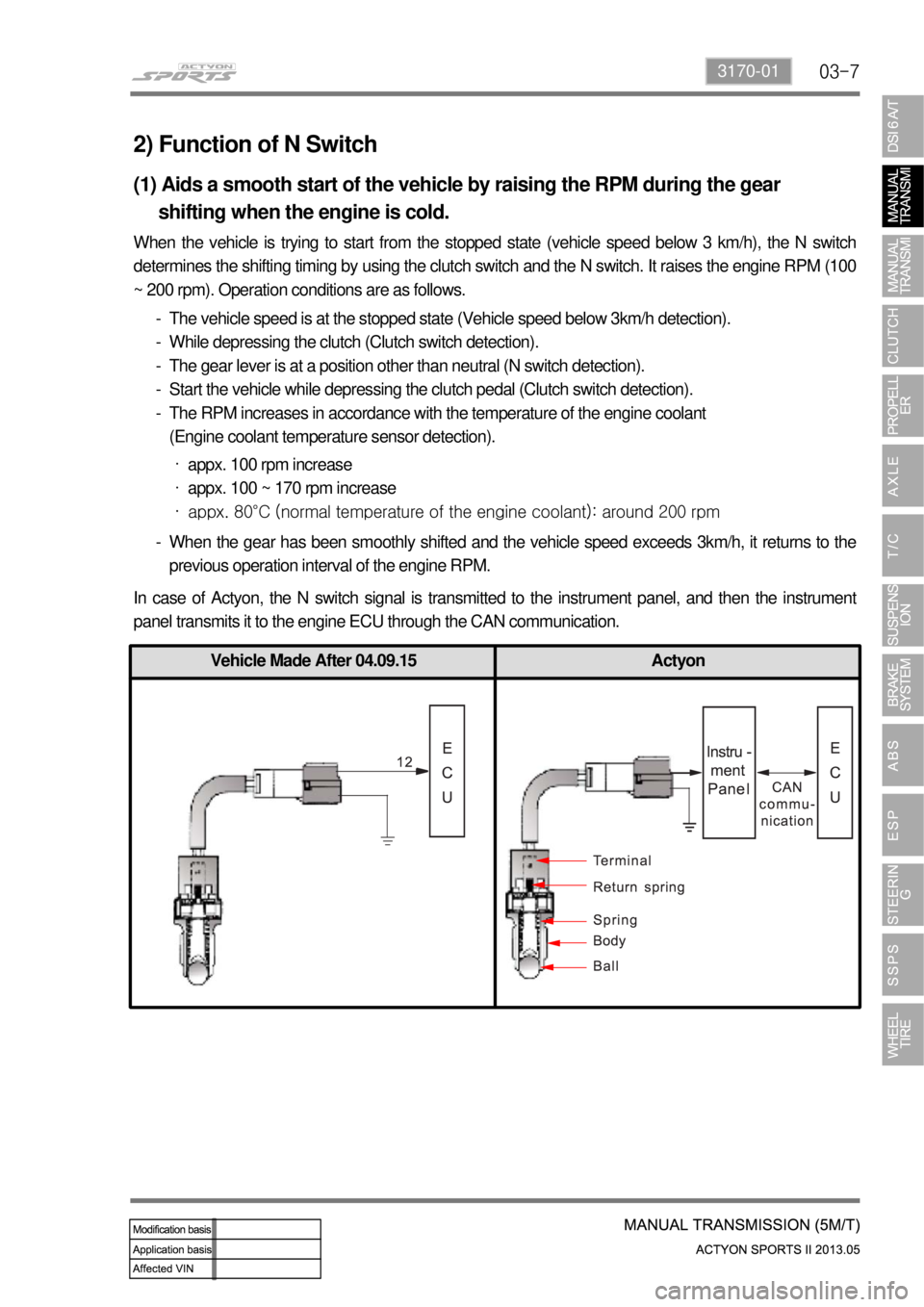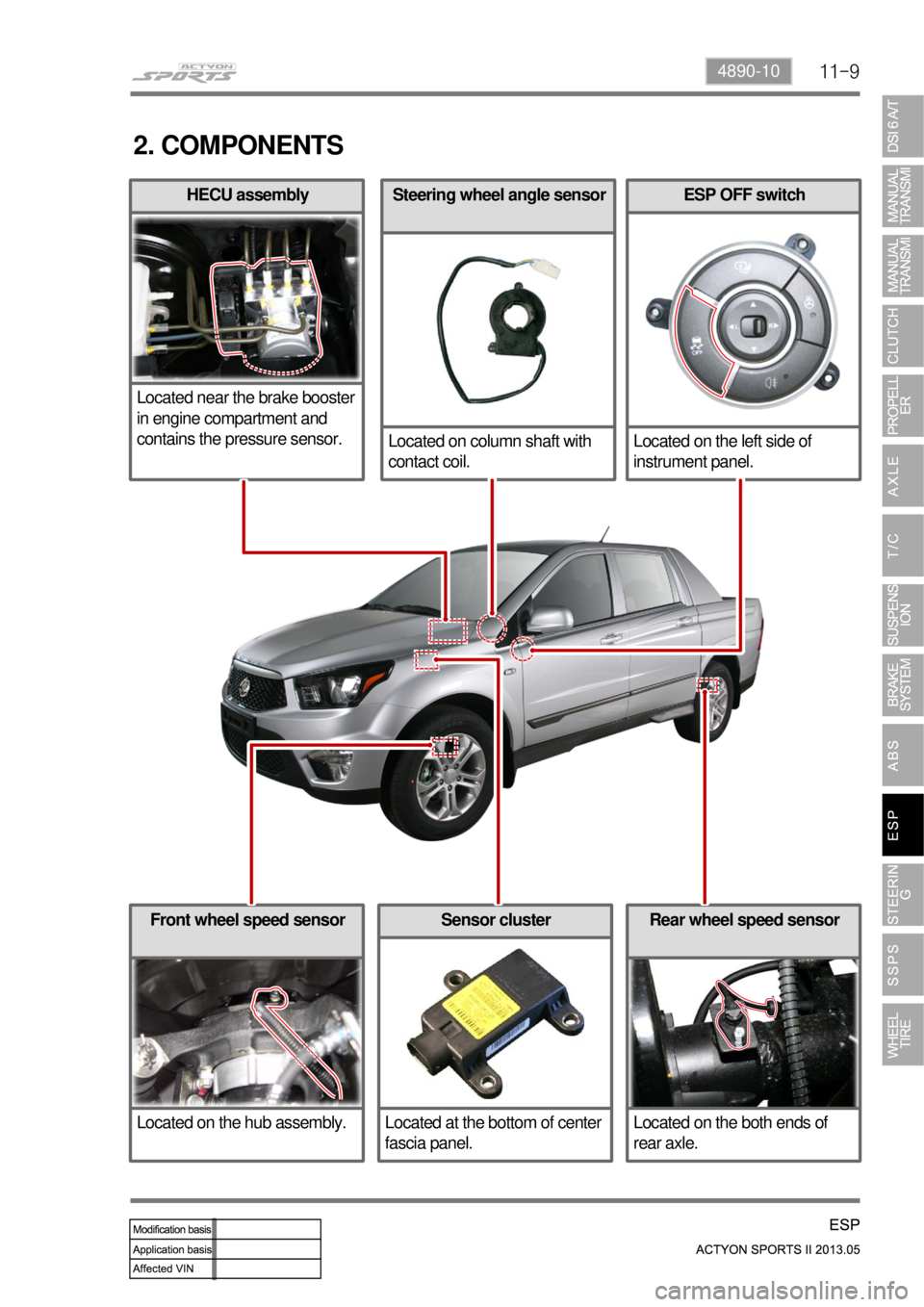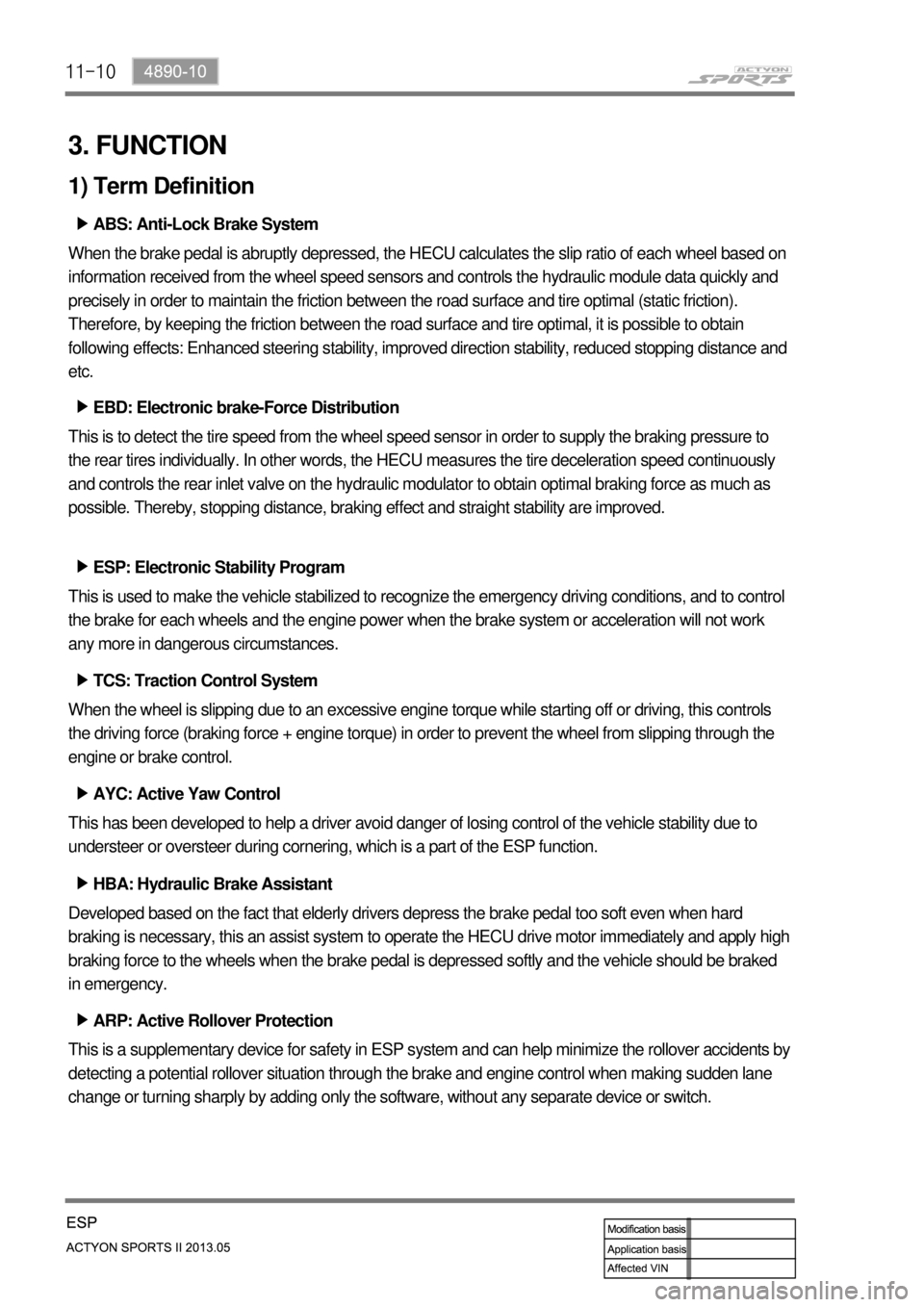Engine ecu SSANGYONG NEW ACTYON SPORTS 2013 Workshop Manual
[x] Cancel search | Manufacturer: SSANGYONG, Model Year: 2013, Model line: NEW ACTYON SPORTS, Model: SSANGYONG NEW ACTYON SPORTS 2013Pages: 751, PDF Size: 72.63 MB
Page 499 of 751

03-73170-01
2) Function of N Switch
(1) Aids a smooth start of the vehicle by raising the RPM during the gear
shifting when the engine is cold.
When the vehicle is trying to start from the stopped state (vehicle speed below 3 km/h), the N switch
determines the shifting timing by using the clutch switch and the N switch. It raises the engine RPM (100
~ 200 rpm). Operation conditions are as follows.
The vehicle speed is at the stopped state (Vehicle speed below 3km/h detection).
While depressing the clutch (Clutch switch detection).
The gear lever is at a position other than neutral (N switch detection).
Start the vehicle while depressing the clutch pedal (Clutch switch detection).
The RPM increases in accordance with the temperature of the engine coolant
(Engine coolant temperature sensor detection). -
-
-
-
-
appx. 100 rpm increase
appx. 100 ~ 170 rpm increase
<008800970097009f00550047005f005700b6006a0047004f0095009600990094008800930047009b008c00940097008c00990088009b009c0099008c00470096008d0047009b008f008c0047008c0095008e00900095008c0047008a009600960093008800
95009b005000610047008800990096009c0095008b00470059>00 rpm ·
·
·
When the gear has been smoothly shifted and the vehicle speed exceeds 3km/h, it returns to the
previous operation interval of the engine RPM. -
In case of Actyon, the N switch signal is transmitted to the instrument panel, and then the instrument
panel transmits it to the engine ECU through the CAN communication.
Vehicle Made After 04.09.15 Actyon
Page 500 of 751

03-8
Variant Coding Options
(2) Detects the position of the shifting lever for the HDC operation
among ABS functions.
The HDC function operates only if the M/T shift lever is in forward or reverse position. Please refer to the
ABS section for the specific information related to the HDC.
Variant Coding Related to N Switch ▶
The N switch transmits information to the ECU through the CAN communication while New Rexton is
connected to the ECU through wires. Thus, if you set the variant coding in the engine ECU, you must do
it differently, and you must set the variant coding differently according to the vehicle category and
specification as below.
Neutral Signal Input None / Wire / CANWire /
Actyon & Kyron models with
manual transmission
New Rexton model with manual
transmission Manufactured after
04.09.15
BODY IN: after 154600
Automatic transmission & Rodius
model with automatic transmission
before 2006
Page 610 of 751

11-8
1. OVERVIEW
The ESP (Electronic Stability Program) has been developed to help a driver avoid danger of losing
control of the vehicle stability due to understeer or oversteer during cornering. The yaw rate sensor,
lateral sensor and longitudinal sensor in the sensor cluster and the steering wheel angle sensor under
the steering column detect the vehicle conditions when the inner or outer wheels are spinning during
oversteer, understeer or cornering. The ESP ECU controls against oversteer or understeer during
cornering by controlling the vehicle stability using input values from these sensors and applying the
braking force to the corresponding wheels independently. The system also controls the engine power
right before the wheel spin synchronized to decelerate the vehicle automatically in order to maintain the
vehicle stable during cornering.
Page 611 of 751

11-94890-10
ESP OFF switch
Located on the left side of
instrument panel.
Rear wheel speed sensor
Located on the both ends of
rear axle.Front wheel speed sensor
Located on the hub assembly.Sensor cluster
Located at the bottom of center
fascia panel.
Steering wheel angle sensor
Located on column shaft with
contact coil.HECU assembly
Located near the brake booster
in engine compartment and
contains the pressure sensor.
2. COMPONENTS
Page 612 of 751

11-10
3. FUNCTION
1) Term Definition
ABS: Anti-Lock Brake System ▶
When the brake pedal is abruptly depressed, the HECU calculates the slip ratio of each wheel based on
information received from the wheel speed sensors and controls the hydraulic module data quickly and
precisely in order to maintain the friction between the road surface and tire optimal (static friction).
Therefore, by keeping the friction between the road surface and tire optimal, it is possible to obtain
following effects: Enhanced steering stability, improved direction stability, reduced stopping distance and
etc.
EBD: Electronic brake-Force Distribution ▶
This is to detect the tire speed from the wheel speed sensor in order to supply the braking pressure to
the rear tires individually. In other words, the HECU measures the tire deceleration speed continuously
and controls the rear inlet valve on the hydraulic modulator to obtain optimal braking force as much as
possible. Thereby, stopping distance, braking effect and straight stability are improved.
ESP: Electronic Stability Program ▶
This is used to make the vehicle stabilized to recognize the emergency driving conditions, and to control
the brake for each wheels and the engine power when the brake system or acceleration will not work
any more in dangerous circumstances.
TCS: Traction Control System ▶
When the wheel is slipping due to an excessive engine torque while starting off or driving, this controls
the driving force (braking force + engine torque) in order to prevent the wheel from slipping through the
engine or brake control.
AYC: Active Yaw Control ▶
This has been developed to help a driver avoid danger of losing control of the vehicle stability due to
understeer or oversteer during cornering, which is a part of the ESP function.
HBA: Hydraulic Brake Assistant ▶
Developed based on the fact that elderly drivers depress the brake pedal too soft even when hard
braking is necessary, this an assist system to operate the HECU drive motor immediately and apply high
braking force to the wheels when the brake pedal is depressed softly and the vehicle should be braked
in emergency.
ARP: Active Rollover Protection ▶
This is a supplementary device for safety in ESP system and can help minimize the rollover accidents by
detecting a potential rollover situation through the brake and engine control when making sudden lane
change or turning sharply by adding only the software, without any separate device or switch.
Page 618 of 751

11-16
2) Operation of ESP System
The ESP (Electronic Stability Program) has been developed to help a driver avoid danger of losing
control of the vehicle stability due to understeer or oversteer during cornering. The yaw rate sensor,
lateral sensor and longitudinal sensor in the sensor cluster and the steering wheel angle sensor under
the steering column detect the vehicle conditions when the inner or outer wheels are spinning during
oversteer, understeer or cornering. The ESP ECU controls against oversteer or understeer during
cornering by controlling the vehicle stability using input values from these sensors and applying the
braking force to the corresponding wheels independently. The system also controls the engine power
right before the wheel spin synchronized with the ASR function to decelerate the vehicle automatically in
order to maintain the vehicle stable during cornering.
(1) Under steering
What is understeering? ▶
Understeer is a term for a condition in which the steering wheel is steered to a certain angle during driving
and the front tires slip toward the reverse direction of the desired direction. Generally, vehicles are
designed to have understeer. It is because that the vehicle can return back to inside of cornering line
when the steering wheel is steered toward the inside even when the front wheels are slipped outward.
As the centrifugal force increases, the tires can easily lose the traction and the vehicle tends to slip
outward when the curve angle gets bigger and the speed increases.
Page 703 of 751

01-24
5. A/C INPUT/OUTPUT DIAGRAM
Below diagram shows the input/output mapping between the components of FATC A/C and A/C
controller briefly.
▶ A/C compressor control by engine ECU
In case of current vehicle models, the system turns ON or OFF the compressor switch according to the
refrigerant pressure, ambient temperature and condenser temperature to protect the A/C circuits.
However, for the vehicles equipped with DI engine, the engine ECU turns off the A/C compressor unde
r
below conditions, including those above.
Coolant temperature: 20℃ or less
Coolant temperature: 115℃ or more
For approx. 4 sec. after starting the engine
Engine speed: 650 rpm or less
Engine speed: 4,500 rpm or more
During abrupt acceleration for the vehicle equipped with manual transmission 1.
2.
3.
4.
5.
6.
Page 730 of 751

03-6
3. WARNINGS FOR POWER SEAT
Adjust the driver's seat before driving.
Make sure that the seat is firmly secured after adjusting.
Never drive the vehicle with the head restraint removed or lowered excessively. Otherwise, your neck,
spine or other parts of the body can be severely injured in the event of an accident.
If you recline the seatback excessively, you could slide under the seat belt and be injured severely in a
collision.
Do not put any object that could damage the seat on the seat.
The front and rear seats are equipped with the heated wire (seat warmer) system. Using the seat
warmer system excessively may cause minor burns. The following occupants should exercise special
care when using the heated wire seat. 1.
2.
3.
4.
5.
6.
Infant, child, old or handicapped person
Person with sensitive skin
Exhausted person
Persons who is drunk or took medicine which causes drowsiness such as sleeping pills, cold
tablets, etc. -
-
-
-
Do not place anything on the seat that insulates against the heat, such as a blanket or cushion.
Make sure that the head restraints are in place and secured properly. Never drive the vehicle with the
head restraint removed.
To minimize the injuries in a collision or an abrupt stop, make sure the seatback is in the upright
position before driving. If the seatback is reclined too much, the occupant could slide under the seat
belt in a collision or an abrupt stop and cannot be protected properly by the airbag system. 7.
5.
9.
4. CAUTIONS FOR POWER SEAT
You can operate the power seat with the ignition switch OFF. However, frequent operation of the seat
switch with the engine stopped can result in battery becoming discharged.
Operating more than one seat adjustment switch at the same time can cause damage to the seat
motor. Therefore, operate the seat switch only one at a time.
Do not use organic solvents such as benzene, thinner, alcohol or gasoline to prevent the seat cover
from being damaged while cleaning.
Do not operate the seat position adjustment switch forcefully when the seat does not move or it
contacts an object.
If the power seat is not operated, check and correct the problem before driving off. 1.
2.
3.
4.
5.